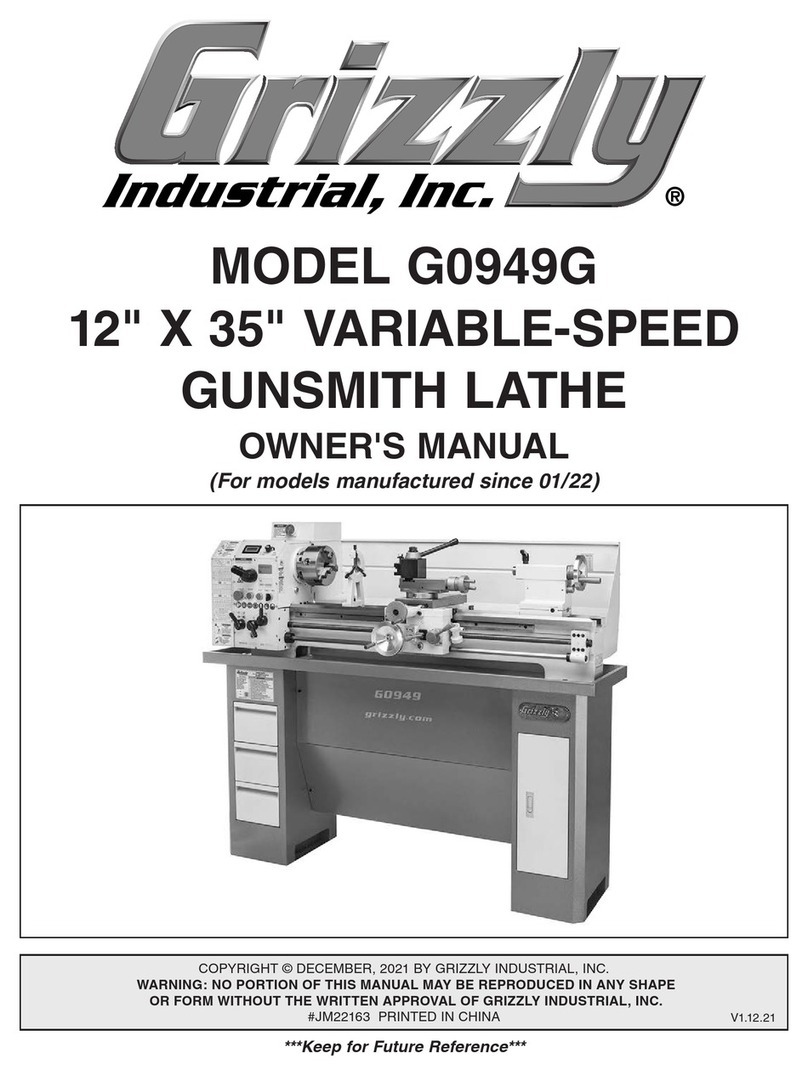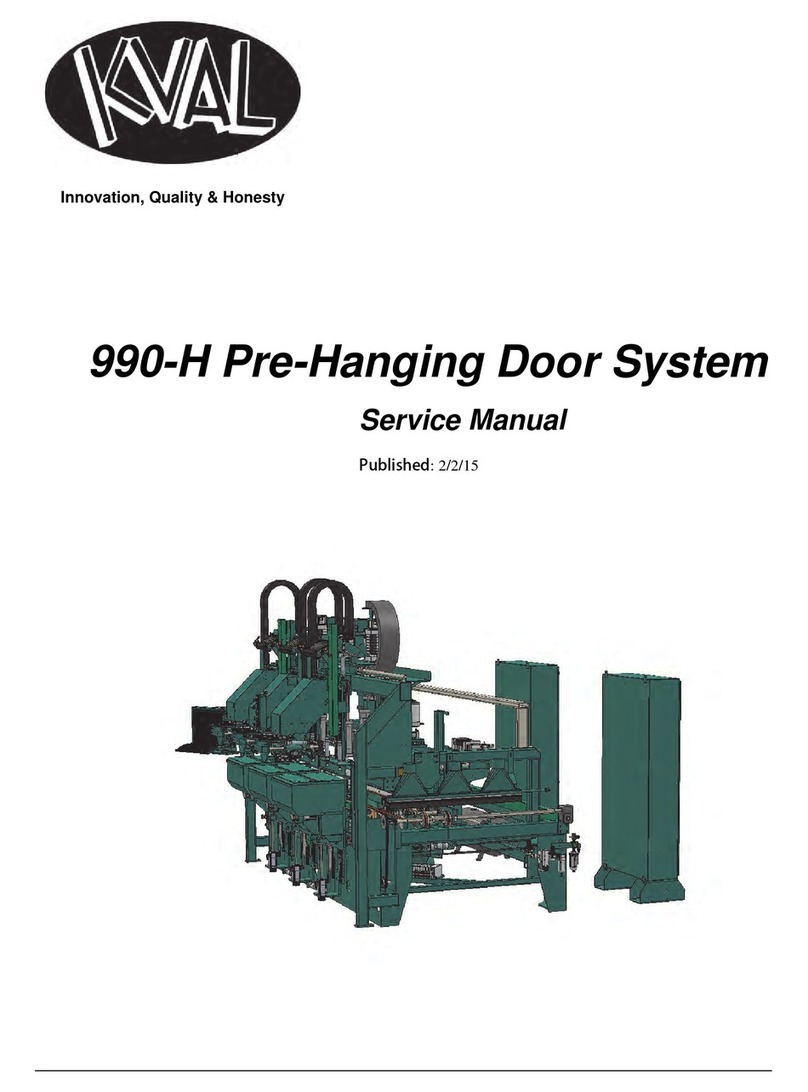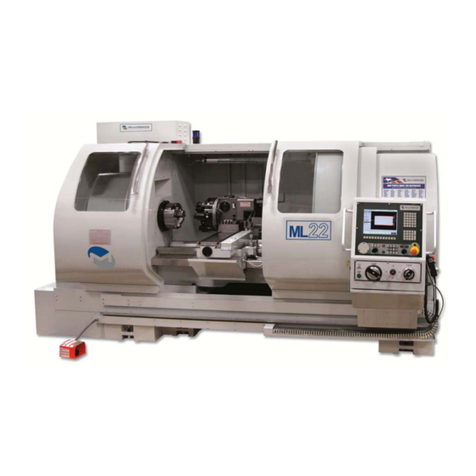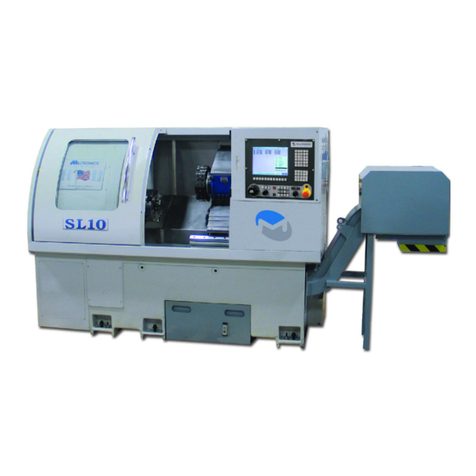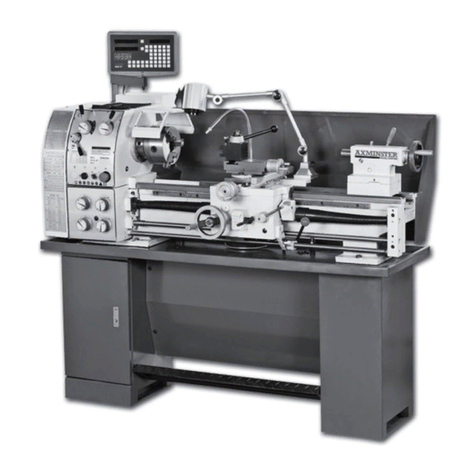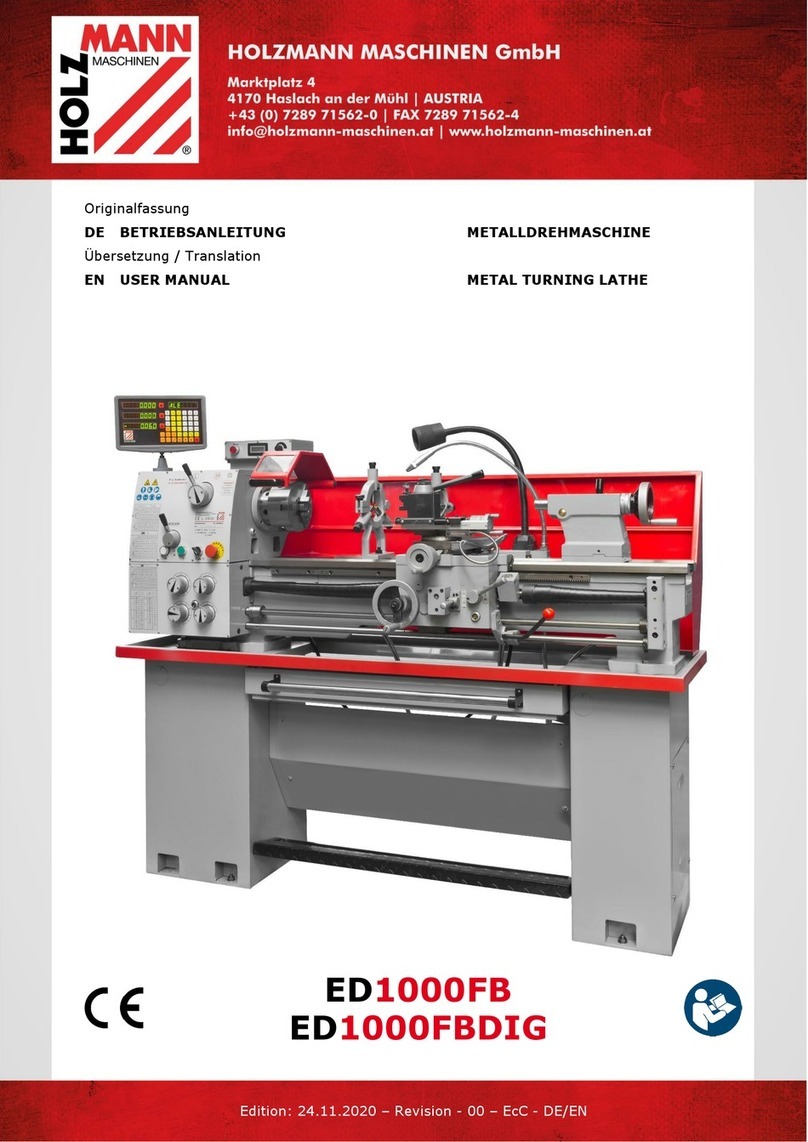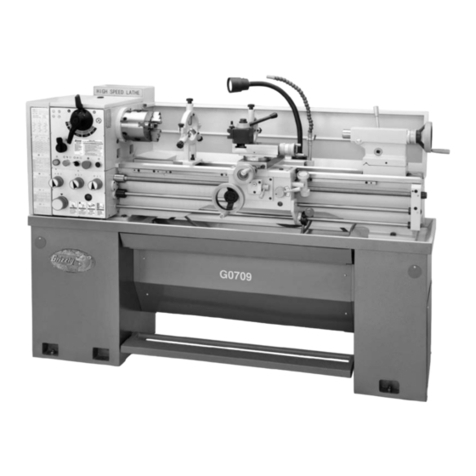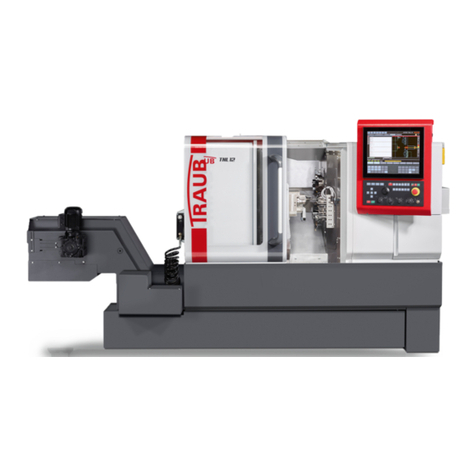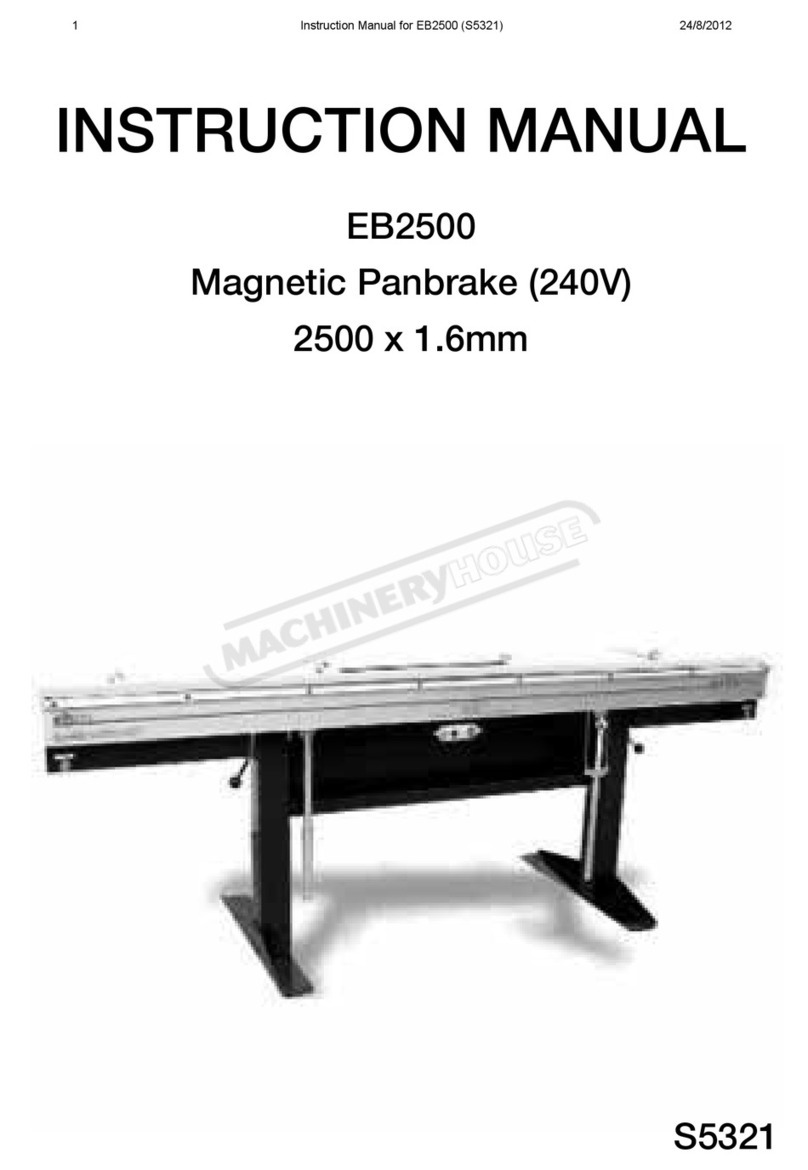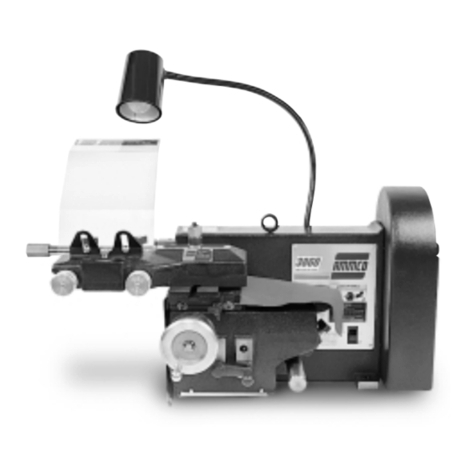MachineryHouse Hafco Metalmaster SRG-12 User manual

OPERATION MANUAL
Edition No : SRG-12-1
Date of Issue : 05/2021
Model. SRG-12
Order Code S267
Manual Sheet Metal Curving Rolls

2
OPERATION MANUAL
NOTE:
In order to see the type and model of the machine, please see the
specication plate. Usually found on the back of the machine. See
example (Fig.1)
Fig.1
Manual Sheet Metal Curving Rolls
MACHINE
SRG-12
MODEL NO.
SERIAL NO.
DATE OF MANF.
DistributeD by
www.machineryhouse.co.nz
MACHINE DETAILS
NOTE:
This manual is only for your reference. Owing to the continuous improvement of the Hafco
Metalmaster machine, changes may be made at any time without obligation or notice. Please
ensure the local voltage is the same as listed on the specication plate before operating this
electric machine.

3
OPERATION MANUAL
SPECIFICATION
Order Code S267
MODEL SRG-12
Useful Length (mm) 305
Capacity - Mild Steel (mm) 1
Roll Diameter (mm) 48
Includes Stand (Yes/ No) No
Wire Groove Positions (No) 3
Dimensions (L x W x H) (cm) 75 x 19.5 x 39.3
Shipping Dimensions (L x W x H) (cm) 42.5 x 18 x 20.5
Nett Weight (kg) 13.6
IDENTIFICATION
AThickness Adjustment Knobs FVise Lug
BUpper Roller GCrank Handle
CGear Guard HLower Roller
DRadius Adjustment Knobs IWorkpiece Support
ERear Roller JUpper Roller Access Slot
B
E
A
DC
F
G
H
I
J
Fig. 1

4
OPERATION MANUAL
GENERAL MACHINE SHOP SAFETY WARNINGS AND PRECAUTIONS
When using this tool, basic safety precautions should always be followed to
reduce the risk of personal injury and damage. Read all instructions before using this tool !
1. Keep the work area clean. Cluttered areas invite injuries.
2. Observe work area conditions. Do not use machines or power tools in damp or wet
locations. Do Not expose to rain. Keep work area well lite. Do not use electrically powered
tools in the presence of ammable gases or liquids.
3. Keep children away. Children must never be allowed in the work area. Do not let them
handle machines, tools, or extension cords.
4. Store idle equipment. When not in use, tools must be stored in a dry location to inhibit
rust. Always lock up tools and keep out of reach of children.
5. Do not force tool. It will do the job better and more safely at the rate for which it was
intended. Do not use inappropriate attachments in an attempt to exceed the tool capacity.
6. Use the right tool for the job. Do not attempt to force a small tool or attachment to do the
work of a larger industrial tool. Do not modify this tool and do not use this tool for a
purpose for which it was not intended.
7. Dress properly. Do not wear loose clothing or jewelry as they can be caught in moving
parts. Protective, electrically non-conductive clothes and non-skid footwear are
recommended when working. Wear restrictive hair covering to contain long hair.
8. Use eye and ear protection. Always wear ANSI approved impact safety goggles. Wear
a full face shield if you are producing metal lings or wood chips. Wear an ANSI approved
dust mask or respirator when working around metal, wood, and chemical dusts and mists.
9. Do not overreach. Keep proper footing and balance at all times. Do not reach over or
across running machines. Keep hands and ngers clear of the Rolls when operating.
10.Maintain tools with care. Keep tools sharp and clean for better and safer performance.
Follow instructions for lubricating and changing accessories. Inspect tool cords periodically
and, if damaged, have them repaired by an authorized technician. The handle must be kept
clean, dry, and free from oil and grease at all times.
11.Remove adjusting keys and wrenches. Check that keys and adjusting wrenches are
removed from the tool or machine work surface before operating.
12.Stay alert. Watch what you are doing, use common sense. Do not operate any tool when
you are tired.
13.Check for damaged parts. Before using any tool, any part that appears damaged should
be carefully checked to determine that it will operate properly and perform its intended
function. Check for alignment and binding of moving parts; any broken parts or mounting
xtures; and any other condition that may aect proper operation. Any part that is
damaged should be properly repaired or replaced by a qualied technician. Do not use the
tool if any switch does not turn on and o properly.
14.Replacement parts and accessories. When servicing, use only identical replacement parts.
Use of any other parts will void the warranty. Only use accessories intended for use with this
tool.

5
OPERATION MANUAL
15.Do not operate tool if under the inuence of alcohol or drugs. Read warning labels
if taking prescription medicine to determine if your judgment or reexes are impaired while
taking drugs. If there is any doubt, do not operate the tool.
16.Maintenance. For your safety, service and maintenance should be performed regularly by a
qualied technician.
17.Workpiece may be sharp. After bending or cutting workpieces use caution. Be aware of
sharp edges or sharp shreds of metal that may be created. Use heavy duty gloves when
handling the workpiece.
The warnings, cautions, and instructions discussed in this instruction
manual cannot cover all possible conditions and situations that may occur. It must be under-
stood by the operator that common sense and caution are factors which cannot be built into
this product, but must be supplied by the operator.
GENERAL MACHINE SHOP SAFETY WARNINGS AND PRECAUTIONS
HAZARDS ASSOCIATED WITH MACHINES include, but are not limited to:
• Being struck by ejected parts of the machinery
• Being struck by material ejected from the machinery
• Contact or entanglement with the machinery
• Contact or entanglement with any material in motion
Health Hazards (other than physical injury caused by moving parts)
• Chemicals hazards that can irritate, burn, or pass through the skin
• Airborne items that can be inhaled, such as oil mist, metal fumes, solvents, and dust
• Heat, noise, and vibration
• Ionizing or non-ionizing radiation (X-ray, lasers, etc.)
• Biological contamination and waste
• Soft tissue injuries (for example, to the hands, arms, shoulders, back, or neck) resulting
from repetitive motion, awkward posture, extended lifting, and pressure grip)
Other Hazards
• Slips and falls from and around machinery during maintenance
• Unstable equipment that is not secured against falling over
• Safe access to/from machines (access, egress)
• Fire or explosion
• Pressure injection injuries from the release of uids and gases under high pressure
• Electrical Hazards, such as electrocution from faulty or ungrounded electrical
components
• Environment in which the machine is used (in a machine shop, or in a work site)

6
OPERATION MANUAL
ADDITIONAL SAFETY FOR MANUAL BENDING ROLLS
Safety glasses must be worn when
operating this equipment
Dust mask must be worn when operating
in high dust areas.
Long and loose hair must be contained
when operating this equipment.
Safety footwear must be worn when
operating this equipment
Close tting/protective clothing must be
worn when operating the machine
Hearing protection must be used when
operating in a noisy environment
DO NOT use this machine unless you have been instructed in its safe use and
operation and have read and understood this manual
PRE-OPERATIONAL SAFETY CHECKS
Locate and ensure you are familiar with all machine operations and controls.
Ensure all guards are tted, secure and functional. Do not operate if guards are missing or
faulty.
Working parts should be well lubricated and the rolls free of rust and dirt.
Check workspaces and walkways to ensure no slip/trip hazards are present.
Be aware of other people in the area and ensure the area is clear before using equipment.
OPERATIONAL SAFETY CHECKS
Adjust both ends of the rollers evenly.
Take care during the initial feeding of the workpiece into the rolls.
Hold the workpiece suciently far back from the edge being fed into the rolls, to allow for the
in-feed speed of the machine.
Wind handle at a slow even rate. Be aware of rotating rollers.
Only one person may operate this machine at any one time.
ENDING OPERATIONS AND CLEANING UP
Ensure the handle is left in a safe position after use.
Leave the work area in a safe, clean and tidy state.
DON’T
Do not use faulty equipment. Immediately report suspect machinery.
Do not attempt to roll material beyond the capacity of the machine.
Do not attempt to bend rod or wire in bending rolls unless the rolls are grooved for this
purpose.
POTENTIAL HAZARDS AND INJURIES
rSharp edges and burrs.
rCrush and pinch points.
rHair/clothing getting caught in moving machine parts.
rOperator’s hands may be caught and drawn into the counter-rotating rollers.

7
OPERATION MANUAL
UNPACKING
This machine was carefully packaged for safe transport. When unpacking, separate all enclosed
items from packaging materials and inspect them for shipping damage. If items are damaged,
please contact your distributor.
NOTE: Save all the packaging materials until you are completely satised with the machine and
have resolved any issues with the distributor, or the shipping agent.
When unpacking, check the packing list to make sure that all parts shown are included. If any
parts are missing or broken, please contact the your distributor.
4 SETUP
The unpainted surfaces of the machine have been coated with a waxy oil to protect them from
corrosion during shipment. Remove the protective coating with a solvent cleaner or a citrus
based degreaser.
Optimum performance from your machine will be achieved when you clean all moving parts or
sliding contact surfaces that are coated with rust prevented products.
It is advised to avoid chlorine based solvents, such as acetone or brake parts cleaner, as they
will damage painted surfaces and strip metal should they come in contact. Always follow the
manufacturer’s instructions when using any type of cleaning product.
CLEAN - UP
SITE PREPARATION
When selecting the site for the machine, consider the largest size of workpiece that will be
processed through the machine and provide enough space around the machine for operat-
ing the machine safely. Consideration should be given to the installation of auxiliary equip-
ment. Leave enough space around the machine to open or remove doors/covers as required
for the maintenance and service as described in this manual.
It is recommended that the machine is anchored to the oor to prevent tipping or shifting. It
also reduces vibration that may occur during operation.
MOUNTING IN VISE
There are substantial forces exerted on the metal
curving rolls during operation. With this in mind,
the curving roll must be rmly secured in a vise
that is solidly attached to a workbench that will
support the weight and dynamic forces of the
operation. (Fig. 2)
Fig. 2

8
OPERATION MANUAL
5. OPERATION
This machine may perform many types of operations that are beyond the scope of this manual.
Many of these operations may be dangerous or deadly if performed incorrectly.
The instructions in this section are written with the understanding that the operator has the
necessary knowledge and skills to operate this machine. If at any time you are experiencing
diculties performing any operation, stop using the machine!
upper roller
lower roller
work table
rear roller
HanD Crank
raDial
aDjustment
tHiCkness
aDjustment
If you are an inexperienced operator, we strongly
recommend that you read books, trade articles, or
seek training from an experienced operator before
performing any unfamiliar operations. Above all,
your safety should come rst!
Thickness Adjustment Knob. Raises and lowers
the upper roller to adjust for the thickness of
dierent workpieces. (Fig. 3)
Radius Adjustment Knob. Raises and lowers
the rear roller to create smaller and larger radius
bends. (Fig. 3)
Hand Crank: Rotates the rollers to feed the
workpiece through the machine. (Fig. 3)
FLAT ROLLING (FIG.4)
Lower the rear roller below the workpiece
path. This will prevent the rear roller from
bending a curve in the workpiece as it is fed
through the slip roll.
CURVE ROLLING (FIG.5)
Use the thickness adjustment knobs to adjust
the height so that you can place the workpiece
between the rollers. Rotate the radius adjustment
knobs counterclockwise to raise the rear roller
Fig. 3
Fig. 4
Fig. 5

9
OPERATION MANUAL
SPARE PARTS SECTION
The following section covers the spare parts diagrams and lists that were current at the time
this manual was originally printed. Due to continuous improvements of the machine, changes
may be made at any time without notication.
HOW TO ORDER SPARE PARTS
1. Have your machines model number, serial number & date of manufacture
on hand, these can be found on the specication plate mounted on the machine
2. A scanned copy of your parts list/diagram with required spare part/s
identied
3. Go to www.machineryhouse.com.au/contactus and ll out the enquiry form attaching a
copy of scanned parts list.
CONTENTS
Spare Parts Diagram............................................... 10
Sparts Parts List ....................................................... 11
Edition No : SRG-12-1
Date of Issue : 05/2021
Model. SRG-12
Order Code S267
Manual Sheet Metal Curving Rolls

10
OPERATION MANUAL
SPARE PARTS DIAGRAM

11
OPERATION MANUAL
SPARE PARTS LIST
ITEM DESCRIPTION QT Y. ITEM DESCRIPTION QT Y.
1
2
3
4
5
6
7
8
9
10
11
12
13
14
ADJUSTMENT KNOB
BASE
GUIDE PLATE
ADJUSTMENT KNOB
LEFT STAND
BUSHING
BOLT M8X35
IDLE SHAFT
WASHER 8MM
RIGHT STAND
BUSHING
WASHER 6MM
SPRING WASHER 6MM
SCREW M6X12
2
1
1
2
1
2
4
1
4
1
3
3
8
9
15
16
17
18
19
20
21
22
23
24
25
26
27
28
SPRING WASHER 8MM
GEAR
UPPER SHAFT
LOWER SHAFT
HANDLE
NUT M10
HANDLE GRIP
SCREW M10X120
WASHER 6MM
KEY
GEAR COVER
PIN
COVER
HEX KEY WRENCH 5MM
4
2
1
1
1
1
1
1
5
2
1
1
1
1
NOTE: SOME INDIVIDUAL PARTS MAY ONLY BE AVAILABLE AS AN ASSEMBLY

General Machinery Safety Instructions
1. Read the entire Manual before starting
machinery. Machinery may cause serious injury if
not correctly used.
2. Always use correct hearing protection when
operating machinery. Machinery noise may cause
permanent hearing damage.
3. Machinery must never be used when tired, or
under the influence of drugs or alcohol. When
running machinery you must be alert at all times.
4. Wear correct Clothing. At all times remove all loose
clothing, necklaces, rings, jewelry, etc. Long hair
must be contained in a hair net. Non-slip protective
footwear must be worn.
5. Always wear correct respirators around fumes
or dust when operating machinery. Machinery
fumes & dust can cause serious respiratory illness.
Dust extractors must be used where applicable.
6. Always wear correct safety glasses. When
machining you must use the correct eye protection
to prevent injuring your eyes.
7. Keep work clean and make sure you have good
lighting. Cluttered and dark shadows may cause
accidents.
8. Personnel must be properly trained or well
supervised when operating machinery. Make
sure you have clear and safe understanding of the
machine you are operating.
9. Keep children and visitors away. Make sure
children and visitors are at a safe distance for you
work area.
10. Keep your workshop childproof. Use padlocks,
Turn off master power switches and remove start
switch keys.
11. Never leave machine unattended. Turn power off
and wait till machine has come to a complete stop
before leaving the machine unattended.
12. Make a safe working environment. Do not use
machine in a damp, wet area, or where flammable
or noxious fumes may exist.
13. Disconnect main power before service
machine. Make sure power switch is in the off
position before re-connecting.
14. Use correct amperage extension cords.
Undersized extension cords overheat and lose
power. Replace extension cords if they become
damaged.
15. Keep machine well maintained. Keep blades
sharp and clean for best and safest performance.
Follow instructions when lubricating and changing
accessories.
16. Keep machine well guarded. Make sure guards
on machine are in place and are all working
correctly.
17. Do not overreach. Keep proper footing and
balance at all times.
18. Secure workpiece. Use clamps or a vice to
hold the workpiece where practical. Keeping the
workpiece secure will free up your hand to operate
the machine and will protect hand from injury.
19. Check machine over before operating. Check
machine for damaged parts, loose bolts, Keys and
wrenches left on machine and any other conditions
that may effect the machines operation. Repair and
replace damaged parts.
20. Use recommended accessories. Refer to
instruction manual or ask correct service officer
when using accessories. The use of improper
accessories may cause the risk of injury.
21. Do not force machinery. Work at the speed and
capacity at which the machine or accessory was
designed.
22. Use correct lifting practice. Always use the
correct lifting methods when using machinery.
Incorrect lifting methods can cause serious injury.
23. Lock mobile bases. Make sure any mobile bases
are locked before using machine.
24. Allergic reactions. Certain metal shavings and
cutting fluids may cause an ellergic reaction in
people and animals, especially when cutting as the
fumes can be inhaled. Make sure you know what
type of metal and cutting fluid you will be exposed
to and how to avoid contamination.
25. Call for help. If at any time you experience
difficulties, stop the machine and call you nearest
branch service department for help.
Machinery House
requires you to read this entire Manual before using this machine.

Manual Sheetmetal Rolls Safety Instructions
1. Maintenance. Make sure all moving parts are
locked down before any inspection, adjustment or
maintenance is carried out.
2. Rolling machine Condition. Rolling machine must
be maintained for a proper working condition. Never
operate a Rolling machine that has damaged or
worn parts. Scheduled routine maintenance should
performed on a scheduled basis.
3. Roll Condition. Never operate a Rolling machine
with a damaged or badly worn Rolls. Replace if
required. Rolls should never be greased or lubricated
as rolls will slip the material and will not bend.
4. Hand Hazard. Keep hands and fingers clear from
moving parts. Serious injury can occur if hand or
finger tips get pinched by rolls and can be dragged
into machine.
5. Gloves & Glasses. Always wear leather gloves and
approved safety glasses when using this machine.
6. Avoiding Entanglement. Rolling machine guards
must be used at all times. Tie up long hair and use
the correct hair nets to avoid any entanglement with
the Rolling machine moving parts.
7. Understand the machines controls. Make sure you
understand the use and operation of all controls.
8. Work area hazards. Keep the area around the
Rolling machine clean from oil, tools, chips. Pay
attention to other persons in the area and know what
is going on around the area to ensure unintended
accidents.
9. Guards. Do not operate this machine without the
correct guards in place. Necessary guards protect
you from injuries by rolls and moving gears and
parts.
10. Material condition. Material must be clean out of
oil and dry. Oily material can slip and will not bend.
11. Material hardness. Make sure your hardness is
the same throughout the material, we recommend
that you use certified material. Never bend hard
steel, glass or fragile material on this machine.
12. Level machine. Level the machine on a flat
concrete surface by using a spirit level.
13. Feeding material. Making a tight bend in one pass
is not possible. So you need several passes before
you can achieve a certain radius. Tighter curves
and full radius always need more passes.
14. Call for help. If at any time you experience
difficulties, stop the machine and call you nearest
branch service department for help.
Machinery House
requires you to read this entire Manual before using this machine.

Manager:
Manual Sheetmetal Rolls
D
SHEARING
Authorised and signed by:
Developed in Co-operation Between A.W.I.S.A and Australia Chamber of Manufactures
This program is based upon the Safe Work Australia, Code of Practice - Managing Risks of Plant in the Workplace ( WHSA 2011 No10 )
NEW MACHINERY HAZARD IDENTIFICATION, ASSESSMENT & CONTROL
Safety officer:
PLANT SAFETY PROGRAM
No.
Hazard
Identification
Item
Hazard
Assessment
CRUSHING
CUTTING, STABBING,
PUNCTURING
MEDIUM
Wear gloves to prevent cuts from sharp material.
B
C
LOW
Risk Control Strategies
(Recommended for Purchase / Buyer / User)
Ensure machine is bolted down.
Secure & support work material.
Keep hands clear from moving parts on rolls.
MEDIUM
Plant Safety Program to be read in conjunction with manufactures instructions
Revised Date:
www.machineryhouse.com.au
www.machineryhouse.co.nz
12th March 2012
This manual suits for next models
1
Table of contents
Other MachineryHouse Lathe manuals






